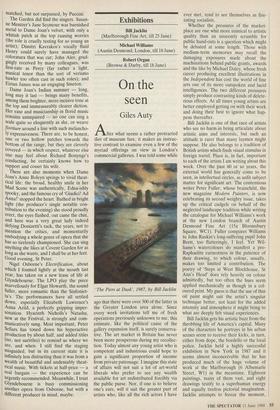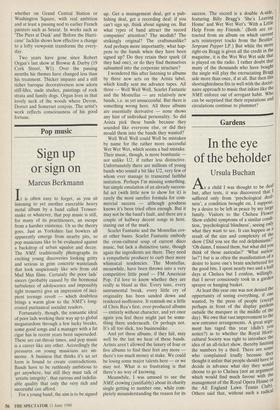Exhibitions
Bill Jacklin (Marlborough Fine Art, till 25 June) Michael Williams (Austin Desmond, London, till 18 June) Robert Organ (Browse & Darby, till 18 June)
On the seen
Giles Auty
After what seems a rather protracted diet of museum fare, it makes an instruc- tive contrast to examine even a few of the myriad offerings on view in London's commercial galleries. I was told some while The Piers at Dusk', 1987, by Bill Jacklin ago that there were over 300 of the latter in the Greater London area alone. Since every week invitations tell me of fresh operations previously unknown to me, this estimate, like the political cause of the gallery expansion itself, is surely conserva- tive. The art market in Britain has never been more prosperous during my recollec- tion. Today almost any young artist who is competent and industrious could hope to gain a significant proportion of income from private patronage. I imagine this state of affairs will not suit a lot of art-world liberals who prefer to see any wealth available for art redistributed forcibly via the public purse. Nor, if one is to believe one's ears, will it suit the greater part of artists who, like all the rich actors I have ever met, tend to see themselves as fire- eating socialists.
Whether the pressures of the market- place are one whit more inimical to artistic quality than an unseemly scramble for public hand-outs is a question which might be debated at some length. Those with medium-term memories may recall the damaging exposures made about the machinations behind public grants, awards and the like by Michael Daley, whose fresh career producing excellent illustrations in the Independent has cost the world of fine arts one of its more outspoken and lucid intelligences. The two different pressures simply produce contrasting kinds of delete- rious effects. At all times young artists are better employed getting on with their work and doing their best to ignore what hap- pens thereafter.
Bill Jacklin is one of that race of artists who see no harm in being articulate about artistic aims and interests, but such an attitude is rarer than many laymen might suppose. He also belongs to a tradition of British artists which finds visual stimulus in foreign travel. Place is, in fact, important to each of the artists I am writing about this week. Over the past 60 or so years, the external world has generally come to be seen, in intellectual circles, as unfit subject matter for significant art. The contentious writer Peter Fuller, whose brainchild, the new magazine Modern Painters, is now celebrating its second weighty issue, takes up the critical cudgels on behalf of the neglected landscape tradition while writing the catalogue for Michael Williams's work at the new London branch of Austin Desmond Fine Art (15a Bloomsbury Square, WC1). Fuller compares Williams to John Ruskin's long-suffering pupil John Brett, too flatteringly, I feel. Yet Wil- liams's watercolours do manifest a pre- Raphaelite earnestness in the patience of their drawing, to which colour, usually, makes too limited a contribution. The poetry of 'Steps at West Blockhouse, St Ann's Head' does rely heavily on colour admittedly, but too often the hues seem applied mechanically as though in a col- oured print. My guess is that the use of thin oil paint might suit the artist's singular technique better, not least for the added intensity and atmosphere it might bring to what are deeply felt visual experiences.
Bill Jacklin gets his artistic buzz from the throbbing life of America's capital. Many of the characters he portrays in his urban scenes seem to receive their kicks, in turn, either from dope, the bordello or the local police. Jacklin held a highly successful exhibition in New York in 1987 and it seems almost inconceivable that he has produced much of the huge volume of work at the Marlborough (6 Albemarle Street, W1) in the meantime. Eighteen paintings, many of them vast, and eight drawings testify to a superhuman energy and equally tireless pictorial imagination. Jacklin attempts to freeze the moment, whether on Grand Central Station or Washington Square, with real ambition and at least a passing nod to earlier French painters such as Seurat. In works such as 'The Piers at Dusk' and 'Before the Hurri- cane' Jacklin shows how effective a change to a lofty viewpoint transforms the every- day.
Two years have gone since Robert Organ's last show at Browse & Darby (19 Cork Street, W1). Over the passing months his themes have changed less than his treatment. Thicker impasto and a still richer baroque decorativeness now adorn still-fifes, nude studies, paintings of rock strata and family dogs. Organ lives in that lovely neck of the woods where Devon, Dorset and Somerset conjoin. The artist's work reflects consciousness of his good fortune.



































































 Previous page
Previous page